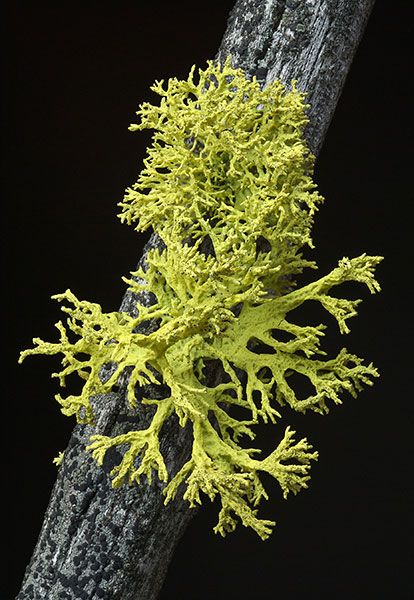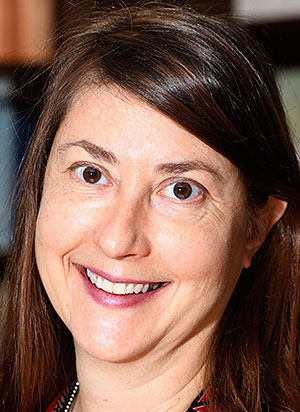July 21, 2016
Yeast emerges as hidden third partner in lichen symbiosis
 Letharia vulpina, often found in Montana forests, is one of many lichen species worldwide that houses yeast as a third symbiotic partner. (Photo courtesy of Tim Wheeler)
Download image
Letharia vulpina, often found in Montana forests, is one of many lichen species worldwide that houses yeast as a third symbiotic partner. (Photo courtesy of Tim Wheeler)
Download image
WEST LAFAYETTE, Ind. - For nearly 150 years, lichens have been the model organisms of symbiosis. Now researchers have uncovered an unexpected third partner embedded in the lichen cortex or "skin" - yeast.
Scientists have long recognized the fundamental partnership that produces lichens: A fungus joins with an alga or cyanobacteria in a relationship that benefits both individuals. In a study led by the University of Montana and co-authored by Purdue mycologist M. Catherine Aime, researchers show that lichens across six continents also contain basidiomycete yeasts, single-celled fungi that likely produce chemicals that help lichens ward off predators and repel microbes.
The finding could explain why many genetically similar lichens present wildly different physical features and why scientists have been unable to synthesize lichens in the laboratory, even when combining species that partner successfully in nature.
"This discovery overturns our longstanding assumptions about the best-studied symbiotic relationship on the planet," said Aime, professor of botany and plant pathology. "These yeasts comprise a whole lineage that no one knew existed, and yet they are in a variety of lichens on every continent as a third symbiotic partner. This is an excellent example of how things can be hidden right under our eyes and why it is crucial that we keep studying the microbial world."
The study was published online by the journal Science on Thursday (July 21) and is available at http://dx.doi.org/10.1126/science.aaf8287. It will appear in the print version of Science as the cover story on July 29.
 M. Catherine Aime
M. Catherine Aime
Download image
Based on his study of lichens, Swiss botanist Simon Schwendener was the first scientist to propose that some organisms are not autonomous individuals but combinations of unrelated species that work together. He observed that lichens are the result of collaboration between a single fungus and a photosynthetic partner - either an alga or cyanobacterium. The alga or cyanobacterium produces food by converting energy from the sun and carbon dioxide into sugars. The fungus, in turn, forms the main structure of the lichen and offers its photosynthesizing partner protection from the environment.
This cross-kingdom combination of strengths and abilities has allowed lichens to thrive on a variety of surfaces and in almost every habitat on the planet, ranging from the Arctic to deserts. They come in myriad shapes, colors and forms and produce a rich variety of secondary metabolites. Lichens were also some of the first land-dwelling organisms, suggesting that a communal effort helped life make the ocean-to-land leap.
The discovery that specific yeasts act as third symbiotic partners in lichens began with an investigation into why two lichen species seemed genetically identical but had distinctive attributes. The lichen Bryoria tortuosa is yellow and produces a toxic substance known as vulpinic acid while B. fremontii - made up of the same fungus and alga - is dark brown and produces no such acid. An analysis of gene expression of the known fungal partner in the two species showed no differences.
But when the team broadened the data search to include all fungi, they found indications that genes were being expressed differently - unexpectedly, by a fungus that appeared to belong to the Basidiomycota, a completely different phylum than the known fungal partner. These data suggested the presence of a second fungus, an undescribed species of yeast in a poorly studied class of early-evolving basidiomycetes.
Toby Spribille, first author of the study and postdoctoral researcher at Montana, said he was initially skeptical of the results.
"It took a long time to convince myself that I wasn't dealing with a contamination," he said.
But once the researchers began looking for traces of similar yeasts in other lichens, they found related lineages in 52 genera of lichens worldwide and molecular evidence that indicates a long, shared evolutionary history between the symbiotic partners.
"There is a long, venerable history of scientists and natural historians who have peered at lichens through microscopes since the 1800s," said Spribille, also a postdoctoral researcher at the University of Graz. "The yeasts were always there, and somehow we got to crack it open. It gives me goose bumps."
The high amounts of yeast in B. tortuosa enable the lichen to produce the acid that helps defend it against invasion from other microbes. Aime's work with related yeasts points to similar beneficial roles in plants, but basidiomycete yeasts are still understudied, she said.
"We have barely touched the tip of the iceberg in understanding the importance and ubiquity of microbes in a variety of biological systems," she said.
The research was supported by funding from an incubation grant from the University of Montana, the Austrian Science Fund, the National Science Foundation, the National Aeronautics and Space Administration Astrobiology Institute and a grant from Stiftelsen Oscar och Lili Lammes minne.
Writer: Natalie van Hoose, 765-496-2050, nvanhoos@purdue.edu
Sources: M. Catherine Aime, 765-496-7853, maime@purdue.edu
Toby Spribille, toby.sprilbille@mso.umt.edu
ABSTRACT
Basidiomycete yeasts in the cortex of ascomycete macrolichens
Toby Sprilbille 1, 2; Veera Tuovinen 3, 4; Philipp Resl 1; Dan Vanderpool 2; Heimo Wolinski 5; M. Catherine Aime 6; Kevin Schneider 1; Edith Stabentheiner 1; Merje Toome-Heller 6; Göran Thor 4; Helmut Mayrhofer 1; Hanna Johannesson 3; John P. McCutcheon 2, 7
1 Institute of Plant Sciences, NAWI Graz, University of Graz, 8010 Graz, Austria
2 Division of Biological Sciences, University of Montana, Missoula, MT 59812, USA
3 Department of Organismal Biology, Uppsala University, Norbyvägen 18D, 752 36 Uppsala, Sweden
4 Department of Ecology, Swedish University of Agricultural Sciences, Post Office Box 7044, SE-75007 Uppsala, Sweden
5 Institute of Molecular Biosciences, BioTechMed Graz, University of Graz, 8010 Graz, Austria
6 Purdue University, Department of Botany and Plant Pathology, West Lafayette, IN 47907, USA
7 Program in Integrated Microbial Biodiversity, Canadian Institute for Advanced Research, Toronto, Ontario, Canada
E-mail: toby.spribille@mso.umt.edu
For over 140 years, lichens have been regarded as a symbiosis between a single fungus, usually an ascomycete, and a photosynthesizing partner. Other fungi have long been known to occur as occasional parasites or endophytes, but the one lichen-one fungus paradigm has seldom been questioned. Here we show that many common lichens are composed of the known ascomycete, the photosynthesizing partner, and, unexpectedly, specific basidiomycete yeasts. These yeasts are embedded in the cortex, and their abundance correlates with previously unexplained variations in phenotype. Basidiomycete lineages maintain close associations with specific lichen species over large geographical distances and have been found on six continents. The structurally important lichen cortex, long treated as a zone of differentiated ascomycete cells, appears to consistently contain two unrelated fungi.
Agricultural Communications: (765) 494-2722;
Keith Robinson, robins89@purdue.edu
Agriculture News Page

